Commissioned by The Keweenaw Symphony Orchestra with support from the National Endowment for the Arts and the National Park Service in honor of the one hundredth anniversary of the National Park Service
Lakescape
Instrumentation: Large Orchestra and Chamber Choir
Duration: 25 minutes
Premiered: December 17, 2017
A lakescape is defined as a land dominated by a lake.
Lakescape is a symphonic work commissioned by the Keweenaw Symphony Orchestra. This project was made possible with support from the National Endowment for the Arts and the National Park Service in honor of the 100th Anniversary of the National Park Service, with additional funding from the National Parks of Lake Superior Foundation.
In the summer of 2016, my colleagues Kent Cyr, Chris Plummer and I traveled to each of the National Parks on Lake Superior collecting sound recordings, photographs and impressions. The separate movements focus on the unique characteristics of an individual Park.
1. Isle Royale National Park: Sunrise Over Rock Harbor
White throated sparrows, white crowned sparrows, loons and chickadees amidst a calm Lake Superior announce the arrival of dawn.
2. Apostle Islands National Lakeshore: Thunk, Splunk, Splash, Crash
Paddling past Meyers Beach, you will come upon some of the most magnificent features of the Apostle Islands National Lakeshore: the sea caves. The sounds of water filled caves are haunting and beautiful.
3. Pictured Rocks National Lakeshore: Ghost Forest
Pictured Rocks National Park is dynamic, with the dunes and shoreline dramatically altered from season to season and year to year by winds and the wave action of Lake Superior. Shifting dunes bury today’s living forests while exposing ancient “Ghost Forests” that are thousands of years old, buried under sand but their standing skeletons of trees occasionally and mysteriously reappear.
4. Keweenaw National Historical Park: For Johnny B.
The Keweenaw National Historical Park was established to preserve and interpret the story of the rise, domination and decline of the region’s copper minor industry. One of the many ways the Historical Park does this is through the collection of oral histories. The text for “For Johnny B.” is taken from an oral history of Giovanni “Johnny” Battista Perona (1920-2009) who was a farmer, laborer, custodian and master musician on spoons, bones and concertina as well as an amateur but serious butterfly enthusiast.
His name was Battista, they called him Bat.
I was born in 1920
My mother was Maria or Mary
I had two sisters and two brothers
His name was Battista, they called him Bat, you know what I mean?
Pa came here first, came here to work in the mines
Ma came here too, they got married in America
They didn’t have money, they paid cheap rent.
The lived on a farm in 1914, you know?
He used to raise flowers on the side, pansies, oh yes.
He sold milk in glass bottles, you know?
Played music, no big deal you know?
Chickens, business, music, no big deal you know?
Burn hard coal upstairs to keep us warm.
There was frost on the walls when the fire went low.
His name was Battista, they called him Bat.
5. Grand Portage National Monument: Jigging at the Monument
Grand Portage National Monument commemorates the cross-cultural exchange among the Ojibwe and early Europeans that influenced the 18th Century exploration of the northwest and expansion of the Great Lakes fur trade industry. “Jigging” can be defined as expressing one’s true emotion through the art of dancing and is a traditional dance of the Métis who trace their descent from indigenous North Americans and European settlers. For this movement, I arranged three fiddle tunes representative of the cultures that would have visited the Grand Portage trading post. Soldier’s Joy is a popular American tune but traces its origins back to Scottish and Irish fiddling traditions and has been played in Scotland for over 200 years. It is one of the oldest and most widely distributed dance tunes. Red River Jig is a popular Métie tune and Tarbolton Reel is of Scottish origin but has made its way into French Canadian canon by fiddler Jean Carignan. For me, these tunes symbolize the great immigrant experience and cultural blending that the Monument preserves.
5. Isle Royale National Park: Lullaby for the Last Wolf/Moonrise Over Tobin Harbor
I have been following the debate over the reintroduction of Wolves at Isle Royale. At last count, two wolves were left and those will likely perish soon if they have not already. I imagined the last wolf and wrote her a lullaby.
In August of 1999, I was an Artist-in-Residence at Isle Royale National Park and spent three weeks in the Dassler cabin located on beautiful Scoville point. It is there that I would hear my first loon call, my first white throated sparrow and saw my first bald eagle in the wild. Behind the cabin was a bench overlooking Tobin Harbor and each night I would sit there to watch the moonrise. The memory and feelings of this have remained with me ever since.







